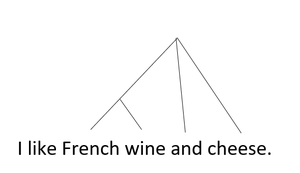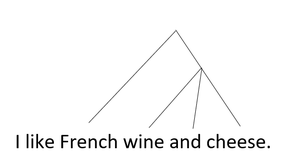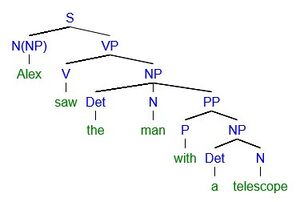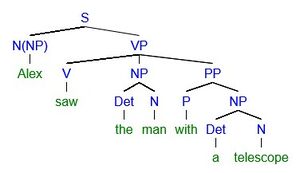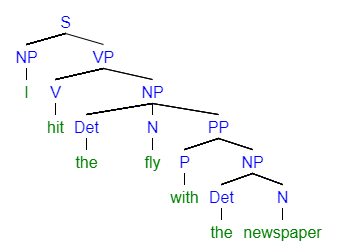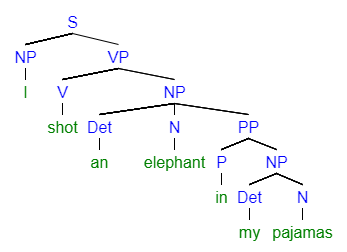User:MMuth
Term paper: L3, FW 2.1, WiSe 20/21
Types of Ambiguity
Check for video transcript here:
It is important to understand what kinds of ambiguity exist in natural language because this will help us to determine the grammatical and contextual factors which allow us to communicate without being lost in ambiguity all the time. The following video will explain the five types of ambiguity.
First of all, let’s talk about Lexical ambiguity. Lexical ambiguity occurs when a sentence contains a word that has more than one meaning which can obscure the writer’s intent and confuse the reader. Let’s take, for example, the sentence: “I saw bats.”. This sentence could be interpreted in four different ways. Number one: I used a tool with a sharp blade to slice through baseball bats. Number two: I viewed some nocturnal flying mammals. Number three: I viewed baseball bats. Number four: I used a tool with a sharp blade to slice through nocturnal flying mammals.
Another type of ambiguity is structural ambiguity. Structural ambiguity occurs when the meaning of the component words can be combined in more than one way. In other words: One word order can be associated with two or more different meanings. For example, the sentence: “The chicken is ready to eat.”. This sentence either means the chicken is cooked and can be eaten now, or the chicken is ready to be fed.
Scope ambiguities arise when the scope of a part - or parts - of a sentence is unclear. The scope is an area over which activity, capacity, or influence extends. Quantifiers (words like every), negations, and adverbial or adjectival modifiers often give rise to scope ambiguities. A sentence with a scope ambiguity need not be structurally ambiguous. For example, the sentence: “Every man loves a woman.”. This sentence could either mean: for every man, there is some woman that he loves, or every man loves the same woman.
Collective-distributive ambiguity occurs with sentences containing plural expressions and can give rise to two interpretations, a collective reading and a distributive reading. For example, the sentence: “Two students carried a heavy backpack.”. In the collective reading, this sentence means that the two students carried one heavy backpack together. In the distributive reading, the two students carried each a heavy backpack.
Referential ambiguity occurs when a word or phrase, in the context of a particular sentence, could refer to two or more properties or things. It is sometimes clear from the context which meaning is intended, but not always. For example, the sentence: “John met Bill before he went to school.”. This sentence could either mean John met Bill before John went to school or John met Bill before Bill went to school. Remember the 5 types of ambiguity are lexical, structural, scope, collective-distributive, and referential ambiguity. Thanks for watching!
Exercise: Determine the type of ambiguity
Structural Ambiguity
Example: I like French wine and cheese.
Check for video transcript here:
Structural ambiguity occurs when the meaning of the component words can be combined in more than one way. In other words: One word order can be associated with two or more different syntactic structures. This can lead to two or more different readings.
In this video I will look at one case of structural ambiguity. In this case one about coordination.
Take the sentence “I like French wine and cheese.” as an example. This sentence could mean I like French wine and any kind of cheese. This would be the constituent structure, where French is a modifier of wine but not of cheese:
The wine has to be French, but the cheese can come from any country. Or this sentence could mean I like French wine and French cheese. This would be the constituent structure where French is a modifier of both wine and cheese.
To test which reading is right you can do a constituent test with the conjunct. The sentence could then be I like French cheese and wine. Here the second reading that I like French wine and French cheese is still correct. However, the first reading that I like French wine and any cheese is not possible anymore. For this first reading to be correct the sentence would have to be converted into I like cheese and French wine. Then it would be structurally clear that French only belongs to one conjunct and not the whole coordination.
Example: Alex saw the man with a telescope.
Check for video transcript here:
Structural ambiguity occurs when the meaning of the component words can be combined in more than one way. In other words: One word order can be associated with two or more different syntactic structures. This can lead to two or more different readings.
In this video I will look at one case of structural ambiguity. In this case one about preposition phrases. Preposition phrases can modify either the noun before it or it can modify the verb in that sentence.
For example, the sentence: “Alex saw the man with a telescope.”. In this sentence we have a preposition phrase that is “with a telescope”. So, the preposition phrase can modify the noun “the man” in that sentence so that it means that Alex saw the man who had a telescope with him. The syntax tree of this reading of the sentence would look like this:
Here you can clearly see that the preposition phrase is part of the noun phrase.
This can be tested through the constituent test: fronting, where the noun phrase is put in front of the sentence. The sentence would then be: It was the man with a telescope that Alex saw. Showing that, in this reading, the man with a telescope is the constituent.
Another constituent test would be pronominalization, where a personal pronoun replaces the noun phrase. In this case the sentence would look like this: Alex saw him. Therefore, in this reading it is clear that the man had the telescope with him.
The preposition phrase can also modify the verb “saw” so that it means that Alex used the telescope to see the man. The syntax tree of this reading of the sentence would look like this:
Here you can clearly see that the preposition phrase is part of the verb phrase.
If you try the fronting test here. The sentence would be: It was the man that Alex saw with a telescope. Here the preposition phrase is outside of the noun phrase. Showing that, in this reading, the man is the constituent.
Or if you try the pronominalization test here the sentence would look like this: Alex saw him with a telescope. Showing that, in this reading, the man is a constituent.
Exercise
